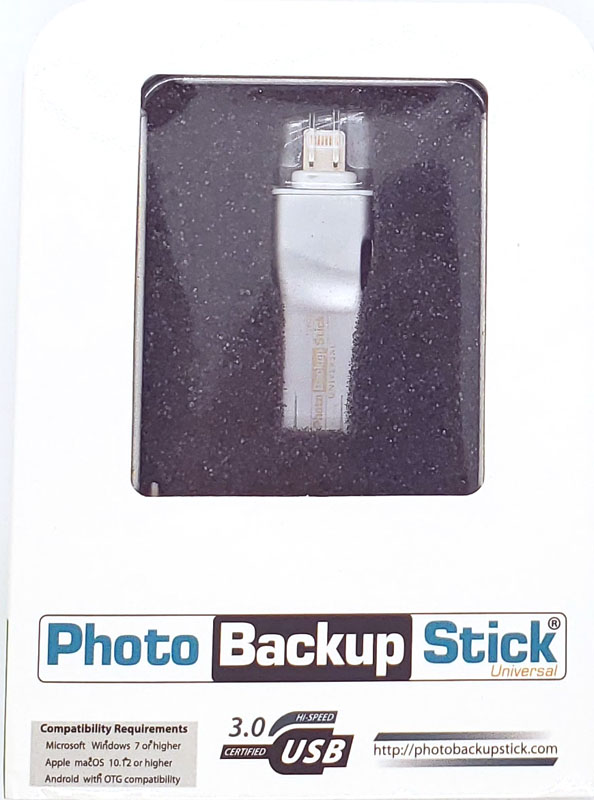
REVIEW – Photos – we all take them, typically with our phones, since that’s the camera we all carry every day. What happens if you lose your phone? If you use cloud services like Amazon, iCloud, or Google, probably nothing as the cloud will protect your precious photo memories. But, what if you don’t use those services? How do you back up all those photos from all their hiding places in your phone’s complex directory structure? Photo Backup Stick is a solution to this problem, offering universal connectivity and proprietary software to back up all your photos and videos.
What is it?
Photo Backup Stick, that I will refer to as “PBS” for brevity, is a “universal” USB photo/video backup device. It can connect to macOS and Windows PCs as well as Android and IOS devices.
What’s in the box?
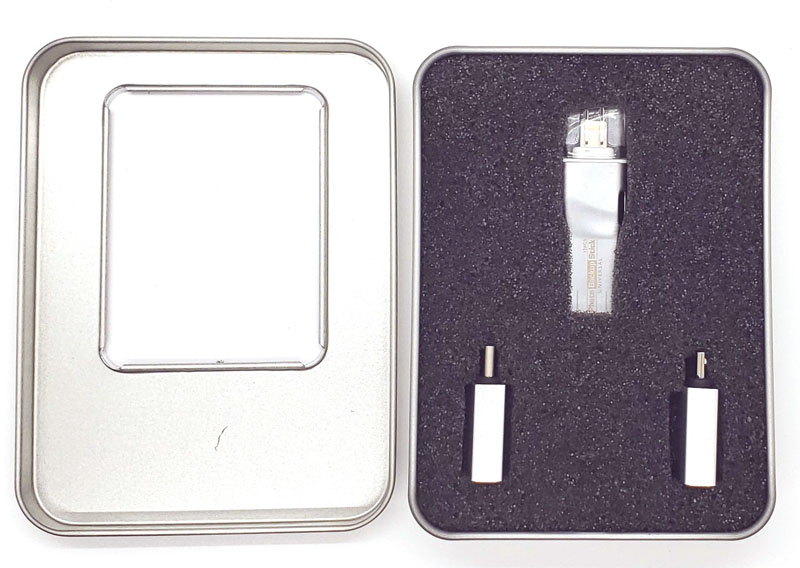
The stick comes heavily packaged in a metal can and foam lining.
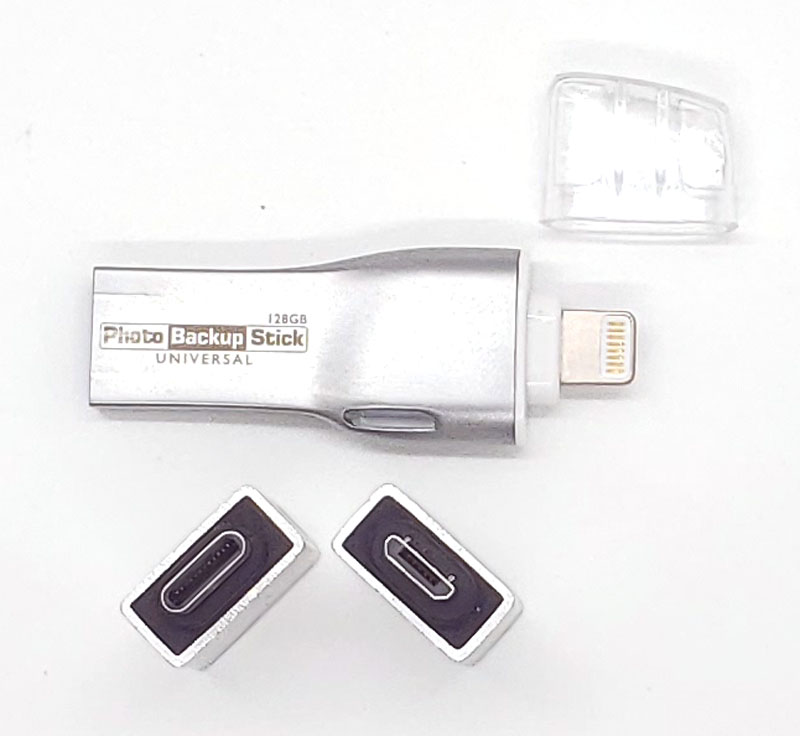
- Photo Backup Stick with removable cap
- USB-A to USB-C adapter
- USB-A to micro-USB adapter
Hardware specs
- Connections: USB-A and Lightning
- Adapters: USB-A to USB-C and USB-A to micro-USB
- Sizes available: 8/16/32/64/128/256GB
Design and features
If you’ve ever seen a USB stick, then you understand the PBS. I was sent the 128GB model for this review. The difference with the PBS is that it has a Lightning connector on one end and a USB-A connector on the other.
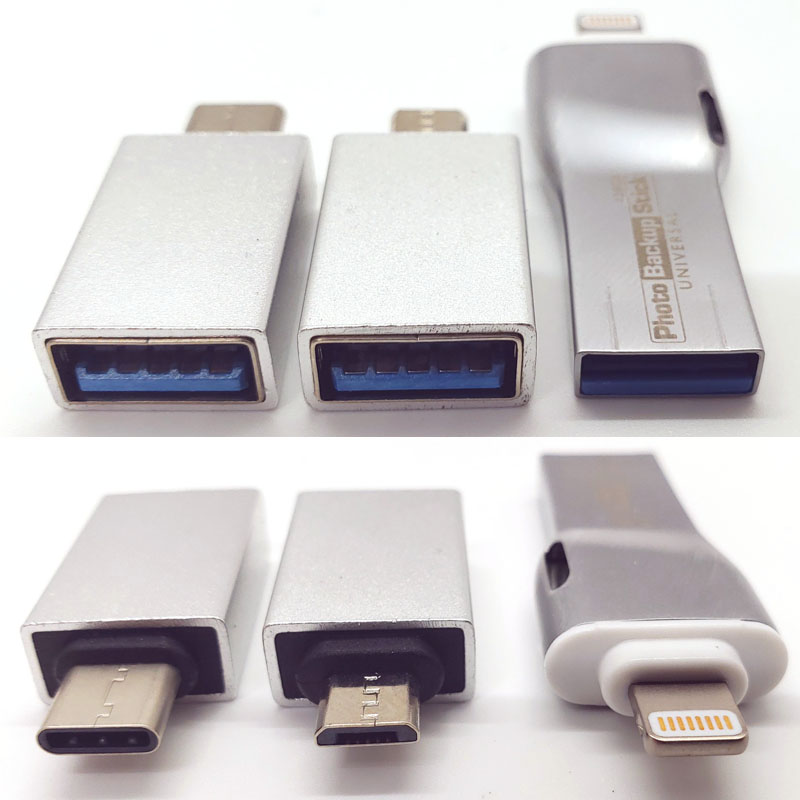
The included adapters slip on the UBS-A connector and allow you to plug the PBS into your phone’s USB-C or micro-USB connection.
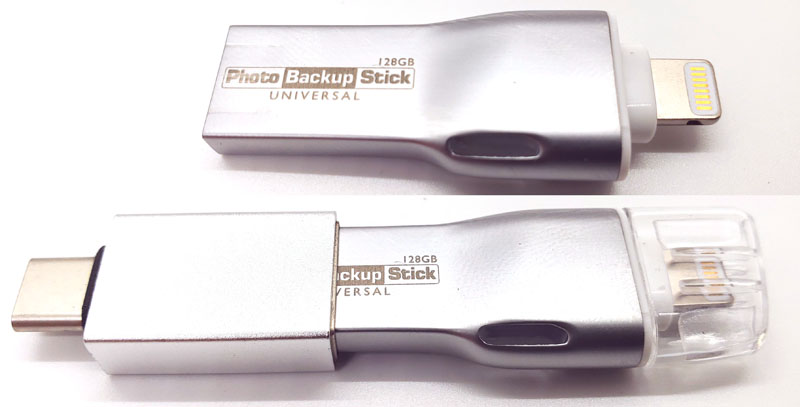
Most USB drives have an LED that flashes to indicate that there is a read/write operation in progress. The PBS does not include a status LED.
Setup
Setup involves downloading the free PBS software from your phone’s app store and slipping the appropriate adapter onto the PBS.
Performance
This is supposed to be dead-simple to use. Plug it into your phone, run the software and choose backup to back up photos, video, or both to the stick. Easy peasy.
I plugged it into the USB-C port of my Samsung Galaxy S9+. I got the following pop-up:
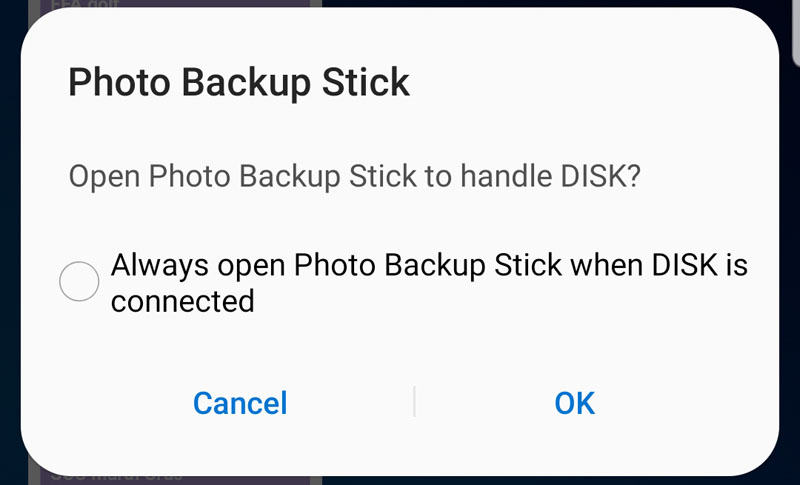
I opted to have the phone automatically fire off the software when I plugged it in. So far, so good.
The software opened as expected. Still firing on all cylinders.
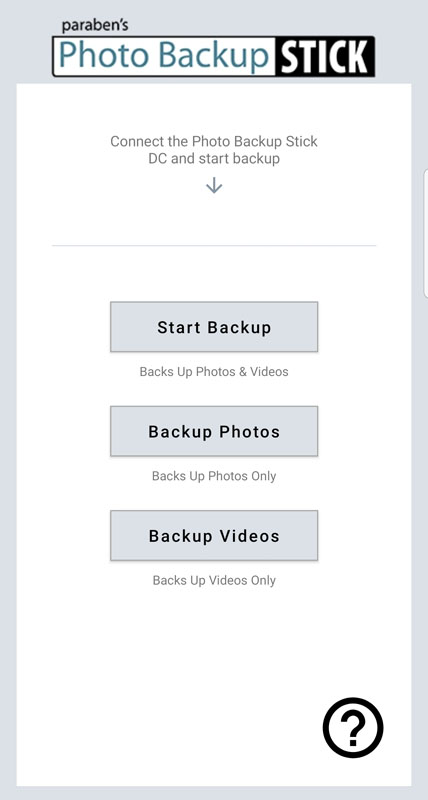
Note that the app is exactly what you see – no options other than backing up photos, videos, or both. You can’t choose source folders – the app has its method of ferreting out all the places you have photos and videos. If you have some sources that you don’t want to be backed up, there is no option to exclude them.
After clicking Start Backup, it started backing up files.
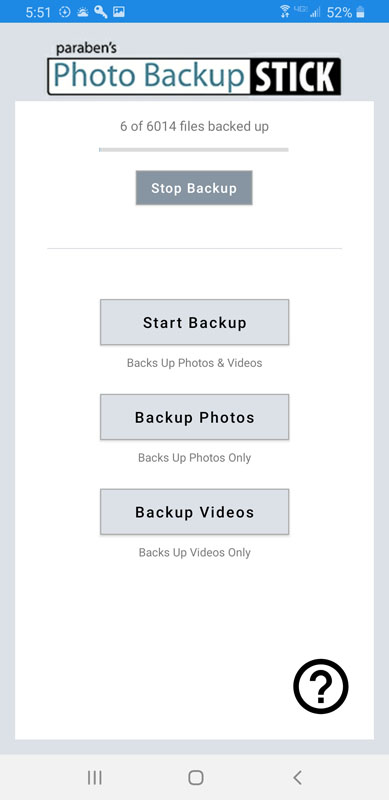
As you can see on top of the screen, it said that I had 6,014 photos and videos that needed backing up and away it went. I let it go for about 1,000 files and stopped the backup. It reported that it had backed up 1,001 files. I restarted the backup and it showed 1,001 fewer files to back up. That’s a good thing. I let another 500 or so go and then stopped as I had to leave. It was running pretty quick, getting 1,600 files, just over 5GB, in only 35 minutes or 143MB per minute. That was great!
When you stop a backup, the software reports what it completed. Here is an image from another manual stop.
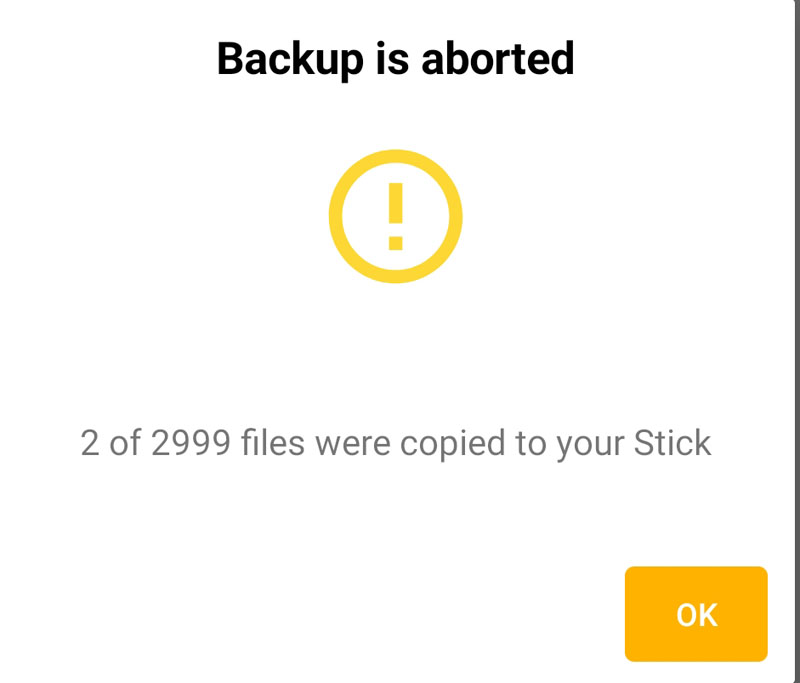
I popped it into my laptop and saw that the backup folder on the stick had all the expected files. The thing is that they are all lumped into a single folder named for the model of your phone with a date/time stamp reflecting when they were backed up.
I plugged the stick back into my phone and started backing up again. It backed up 69 files and only 372MB in 31 minutes. That’s slower – a lot slower.
The one thing I did notice is that backing up all these files absolutely kills my phone battery. Backing up 1,600 files took about 15% of my battery. I decided to back up the rest on the charger while I slept. I started the backup, put the phone on my Qi charger and went to sleep.
My phone restarts every night around 3:30 AM or so, but I figured I’d get several hours of backing up done before then, perhaps even finishing the just over 3,400 remaining files. Wrong. I started backing up about 10:06 PM. It only backed up until 11:06 PM, backing up 898 files and 2.6GB.
In the morning, I had to golf early, so I just unplugged the stick and headed out. When I got home, I plugged in the stick, saw that I had 3,419 files remaining. I started the backup. After 48 minutes, only 420 files backed up. I stopped the backup.
I popped the PBS into my laptop and saw that it backed up 1.38GB, or about 28MB per minute. For a USB3 device, that’s really slow. So far, the first backup started fast but seems to be slowing down as I add files. Right now, I have a total of 3,000 files and 9.5GB on the drive. At the rate it is going, it will take days to back up the remaining 3,000 files. I should also note again that all the files get dumped into a single folder, so trying to find something is somewhat daunting.
The software says that it will only backup new files, meaning that the files that were already backed up remain on the stick and only newly found files get added to the backup set. So far, that seems to be working – the number of files to backup continues to go down, albeit much more slowly as the process continues.
I started a backup again and it showed 2,969 files to back up – pretty much as expected. After nearly an hour, it got through 700 files and dropped my phone’s battery from 65% to 28%. I opted to stop the backup. I hit stop and the application force-closed. I restarted it and it showed that I have 2,969 files to back up – the 700 that it said it backed up before the app crashed were gone and needed to be backed up again. Grrr….
I have been trying for two days to get a full backup and so far, no joy.
After another unsuccessful overnight attempt where I only got through 313 files and 858 MB in 54 minutes before the app died, I had about 45 minutes to spare and started another backup. After 45 minutes and 200 files, I clicked stop and the app died again. So, those 200 files went back onto the pile than still needs backing up. This is day #3 with the stick and I still can’t get a full backup completed.
I ran another overnight backup and for some reason, this one ran well. In 127 minutes, it backed up 1,105 files and 2.05GB. For reference, that backup rate was 16MB per minute. Still incredibly slow compared with the initial backup, but at least it got some stuff backed up. I woke up early and started another backup. It said I had 1,276 files to go. In just a few minutes, it said that it backed up 1,276 files of 1,276 files and was done. I was skeptical so I started another backup and it reported that it had 1,213 to go. Strange again.
I let that backup run. It ended successfully 90 minutes later, reporting 1,213 files.
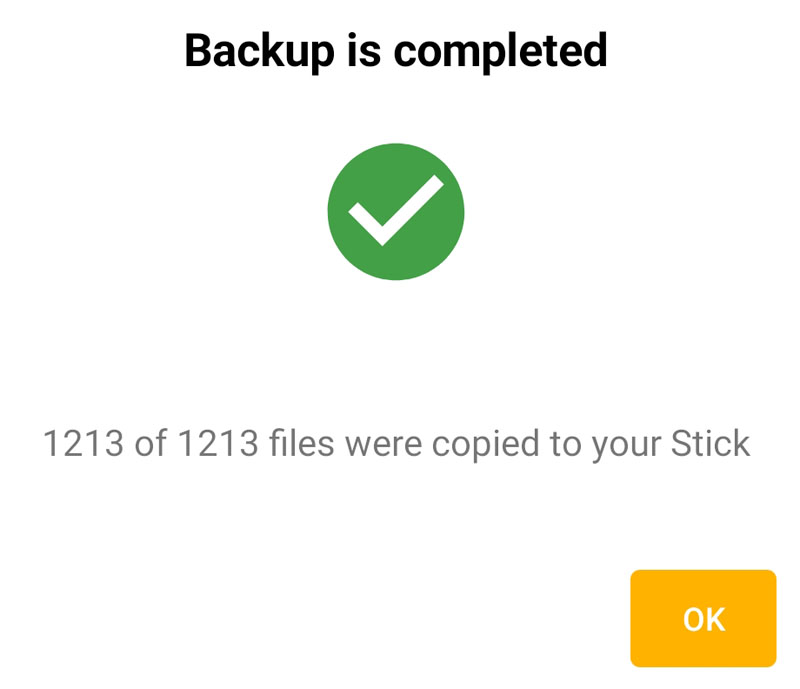
It actually backed up 1,285 files and 7.94GB based on the files listed in Windows Explorer. That was running at 88MB per minute, a better rate than I had been getting.
Again being skeptical, I ran another backup and was pleased to see the following.
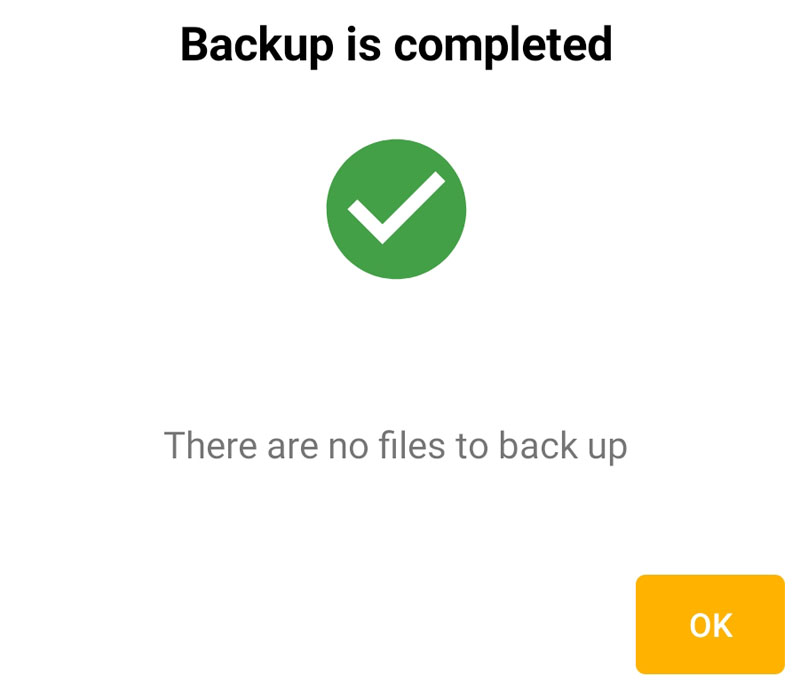
Woo hoo! After several days of fighting, I finally had a full backup. Windows explorer reported that the PBS now contains 6,013 files and 21.3GB. The difference in file count can be attributed to the fact that since I started the backup process three days ago, I have both taken additional photos and deleted some older ones.
If I look at the initial backup that cranked out 1,500 files and 5GB in just over a half an hour, I should have been able to get this backup done in just over a couple of hours. Instead, it turned into a three-and-a-half-day marathon of failures, app crashes, unbelievably slow speeds and untold amounts of frustration.
With the backup completed, the PBS does back up only new files and does so fairly quickly.
Some additional oddities – when I pop the stick into my laptop, Windows 10 says that there is a problem with the drive. When I scan the drive, it shows no errors, but Windows pops that message every time I insert the drive.
I also get the following error from time to time on my phone.
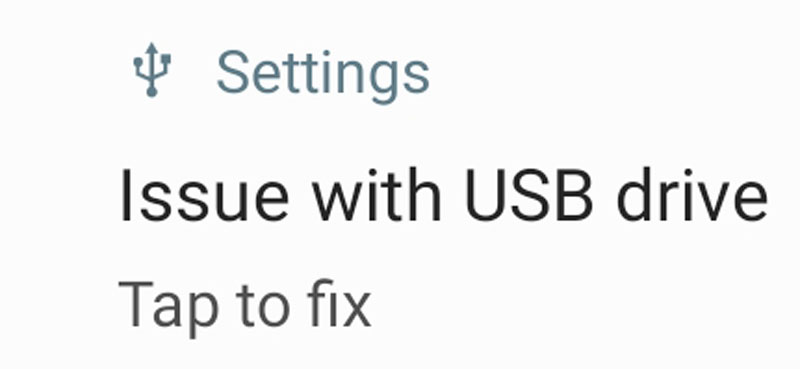
I have no idea what to make of that one, but the backup seems to abort when it pops up.
One time, when I inserted the PBS into my phone, the following popped up:
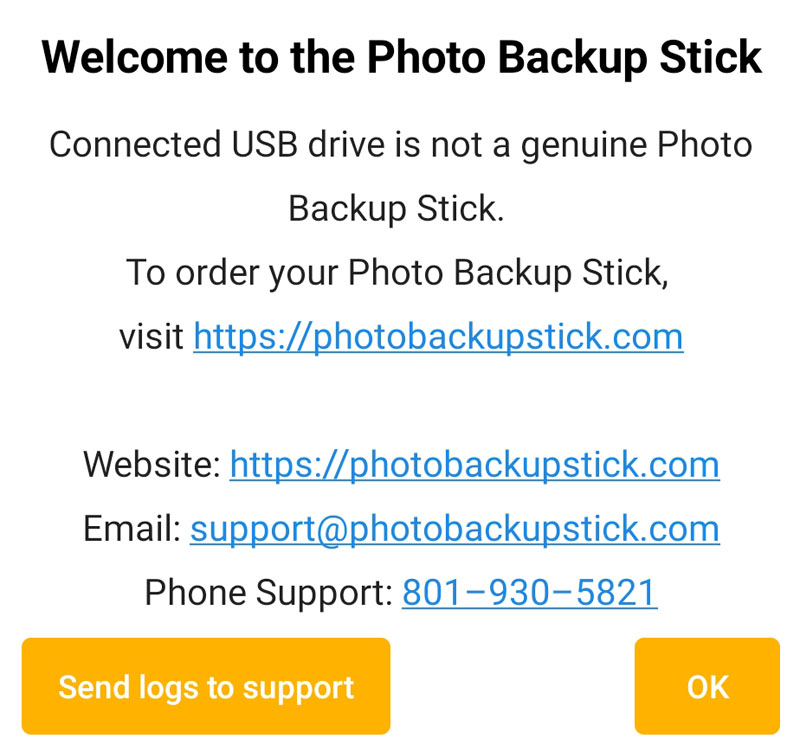
I unplugged it and plugged it back in and the app ran OK.
I should also note that the PBS gets pretty hot when the backup is running. It’s not hot enough to burn, but “toasty” is an accurate description.
What I like
- Plug-in simple
- Does backup files that have not been backed up
- Cross-platform compatibility
What I’d change
- Pricey
- No status LED
- The included app is basic, doesn’t offer any options other than photos only, videos only, or both – no option to exclude any folders
- The backup is all dumped into a single folder and the date/time stamp is updated for the backup date/time
- Backups excessively drains my phone battery
- I don’t know why some backups worked while others appeared to work but did nothing
- Speed seems to be an issue
- App crashes cause whatever was backed up in that individual backup to not be backed up – nothing is lost other than the time the backup ran
- Windows always reports that there is an issue with the stick
Final thoughts
This device had great promise. The very basic software does back up new files, which is good. There isn’t any real set up to do, so that is also good. The fact that all files are dumped into a single folder makes finding files, especially in a large backup, nearly impossible. The speed issues, buggy software, and the battery drain need to be addressed for me to recommend this product.
Price: $59.95 – $169.95 (8GB – 256GB)
Where to buy: Amazon and direct from PhotoBackupStick.com.
Source: The sample of this product was provided by Paraben Consumer Software.




Gadgeteer Comment Policy - Please read before commenting
Nice product but way, way, way too expensive. Before I used cloud backups (big dataplans were pricey), I had a 64 GB mini USB stick and a micro USB OTG connector, combined with the default file manager in Android to back stuff up. Total costs: less than EUR 40.
I received the mid size $64 photo stills. Took hours to load. I tried to view the pictures on the storm but was never able to do this so not sure if the pictures arevthere or not. Decided to send the thing back but paraben has refused to accept the return. Very unhappy with this product.
Will the PSB/software restore Photos affected by ransomware?
William:
We are a review site, not a product support site and have no affiliation with the companies that produce the products we review. I recommend contacting Parabens support.
Having said that – as long as you keep the stick separate from the affected PC and did not back up ransomware-affected files, I don’t know why you couldn’t restore backed up photos to a new, unaffected PC.
Garry
Thanks Garry,
My old desktop was affected by ransomware that corrupted my photos and someone told me about a Photo back up USB
/software that repairs the photos/affected files in the process or backing them up on the Stick? I imagine I would have to ask the manufacturer of the device/usb… but wondering if in your testing you came across details indicating it was possible with the device you reviewed.
Sorry to hear about the attack, William. I have no guidance here. I am not aware of any automatic repair offered during the backup process.
Does this device remove duplicate pictures
Since I could never get the product to work reliably, I can’t answer this. I recommend contacting the company for feature support.